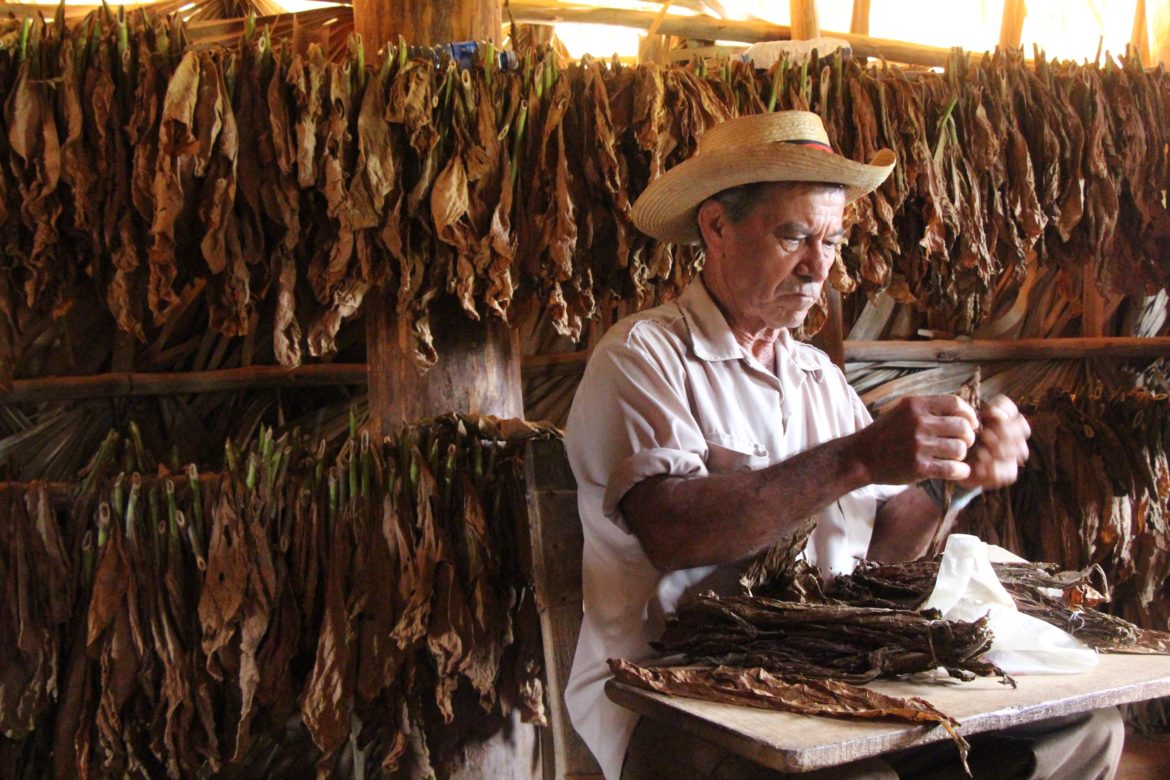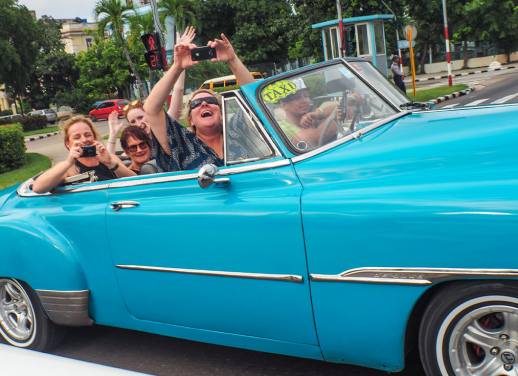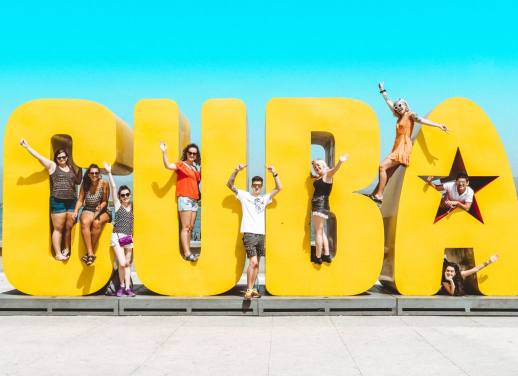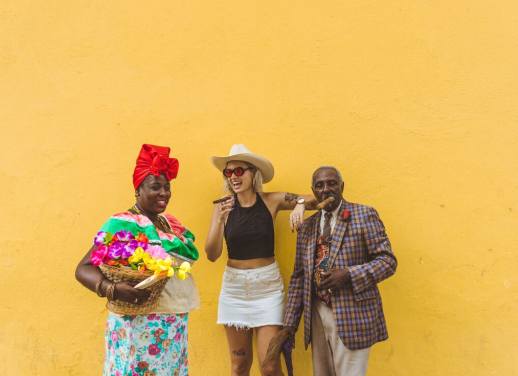On my recent Intrepid Travel tour of Cuba, watching a fourth generation tobacco farmer expertly roll an organic Cuban cigar might just top the list of my favorite experiences. Learning about it instantly connected me, the traveler, with the fascinating history and culture of the famed Cuban cigar.
After all, the Cuban cigar has been a thing of myth and lore in the United States for the last 50 years due to a long-standing trade embargo between the two nations. And as a Chicagoan in Cuba, I found that loosening restrictions are making it easier for US travelers to reconnect with the iconic Habano (Cuban cigar).
Here’s what else I discovered…
History of Cuba’s tobacco industry
Although the tobacco plant did not originate in Cuba, it has been a mainstay crop for thousands of years. When Columbus sailed to the Americas, he “discovered” tobacco and brought it back to Spain for European consumers.
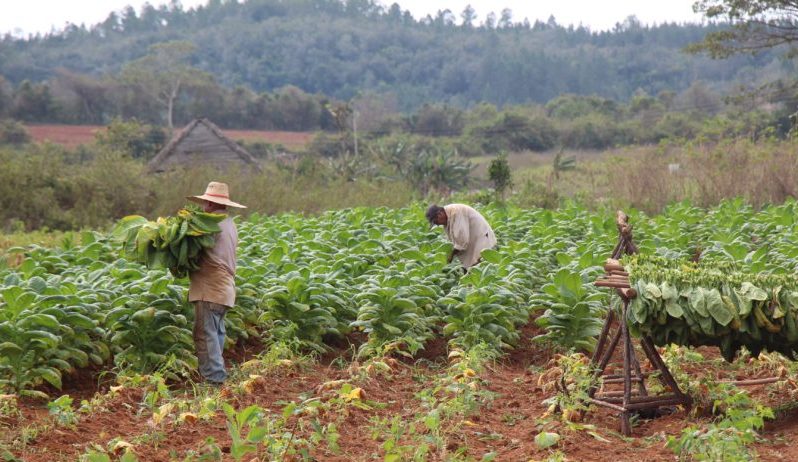 At the height of tobacco’s popularity, there were approximately 10,000 tobacco plantations across the island (several of which are still in existence today) producing millions of cigars every year.
At the height of tobacco’s popularity, there were approximately 10,000 tobacco plantations across the island (several of which are still in existence today) producing millions of cigars every year.
Why are Cuban cigars special?
From the perspective of a non-smoker, I wondered why Cuban cigars are considered special. Having learned about the process now, all the members of my group can proudly explain that there are three main reasons why Cuban cigars are considered the best in the world: ideal growing climate, agricultural diversity in unique soil composition, and experienced workers.
CHECK OUT OUR RANGE OF SMALL GROUP ADVENTURES IN CUBA
Due to consistently warm temperatures, high humidity and regular rainfall, Western Cuba is ideal for tobacco. Flavors and colors will vary depending on where in Cuba the crop is grown but Cuban tobacco’s flavor is generally recognized as strong, smooth and full-bodied.
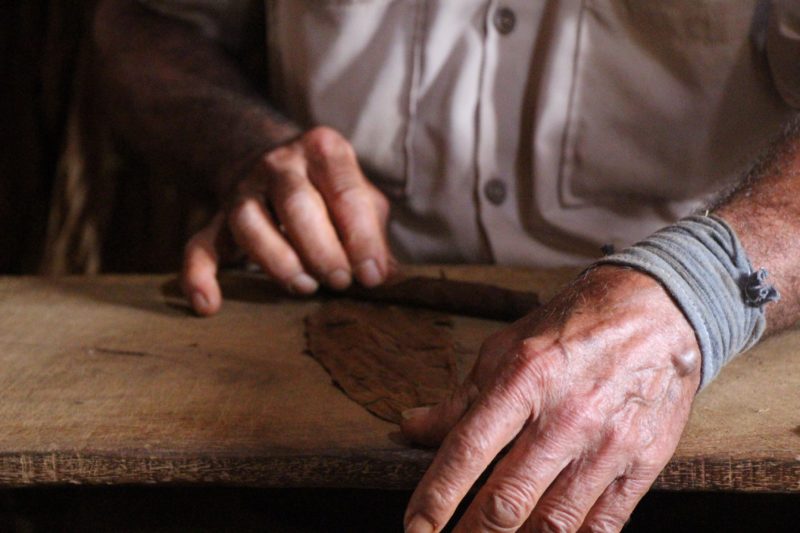 I had no idea there were three different types of tobacco leaves needed for a cigar — the wrapper, filler and binder — and that Cuba is uniquely blessed to be able to produce all three. This allows Cuban cigar makers to control the flavor, texture and composition of their cigars far more easily than other nations that must import leaves from elsewhere.
I had no idea there were three different types of tobacco leaves needed for a cigar — the wrapper, filler and binder — and that Cuba is uniquely blessed to be able to produce all three. This allows Cuban cigar makers to control the flavor, texture and composition of their cigars far more easily than other nations that must import leaves from elsewhere.
With regular access to top-tier tobacco, Cuban cigar houses create expert curated blends for their unique brand. Tobacco tasters can mold a flavor profile around the various leaves available guaranteeing a smooth taste. The country is full of tobacco families that know how to make the best cigars on the market and to this day, the industry employs thousands of Cubans, most of whom are women.
Learning straight from the source
I was lucky enough to visit Roberto, a fourth generation tobacco farmer, on his finca outside of Vinales. With a kind smile and callused hands, Roberto proudly walked our group around his farm, teaching us about the tobacco growing process.
In October, seedlings are hand-planted by farmers and left to grow for about six weeks. Because tobacco is a delicate plant, only natural pesticides can be used. Once the plants are five or six feet high, the harvest will begin.
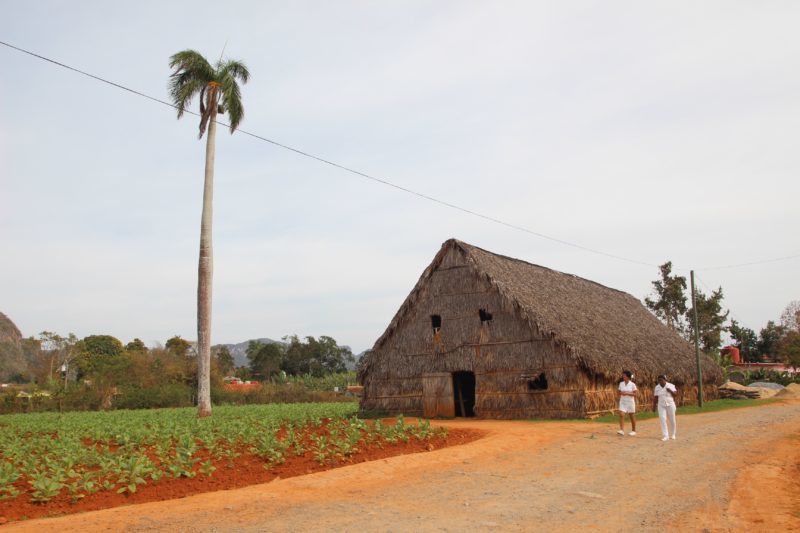
The curing barn on Roberto’s farm
As Roberto explained, this is the most labor intensive part of the process. Because the leaves higher on the plant will have more nicotine and nutrient content, they need to be hand picked separately from the other leaves. After the various grades are harvested, the leaves will be dried and cured.
SUBSCRIBE TO OUR NEWSLETTER FOR TRAVEL INSPO, GIVEAWAYS & MORE
Before I even stepped inside Roberto’s thatch roofed curing barn, I could smell the sweet and sticky aroma of the tobacco leaves fermenting. As I walked in, l looked up to see rows and rows of tobacco leaves slung over the barn’s beams. They were naturally drying from the heat of the sun.
Roberto pulled off a few leaves to show us the fermentation process in action. The sun warms the barn, slowly drying and curing the tobacco. The leaves will start bright green and gradually fade to golden brown as they oxidize. Tobacco will stay in the curing barn for approximately two months.
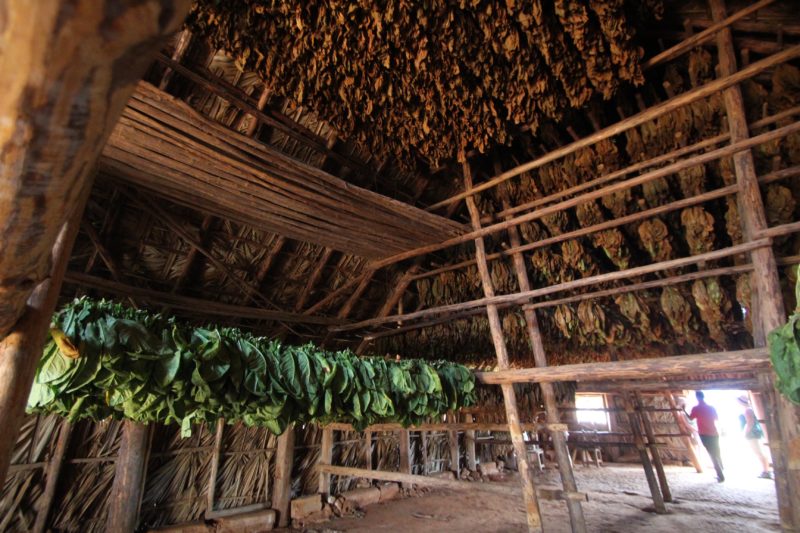
The interior of the curing barn
Connecting with culture
With an ease that comes from many years of experience, Roberto began to teach our group how a Cuban cigar is properly rolled. First, he selected his wrapper leaf (which will be the largest and highest quality), expertly smoothing it out without looking down. Next came a few lesser quality leaves (the binder) layered on top of the wrapper. This was followed by a few smaller or broken leaves for the filler.
Roberto’s hands nimbly rolled and tightly packed the leaves, never damaging their fragility. A cigar that is rolled too tight won’t burn properly; a cigar that is too loose will fall apart.
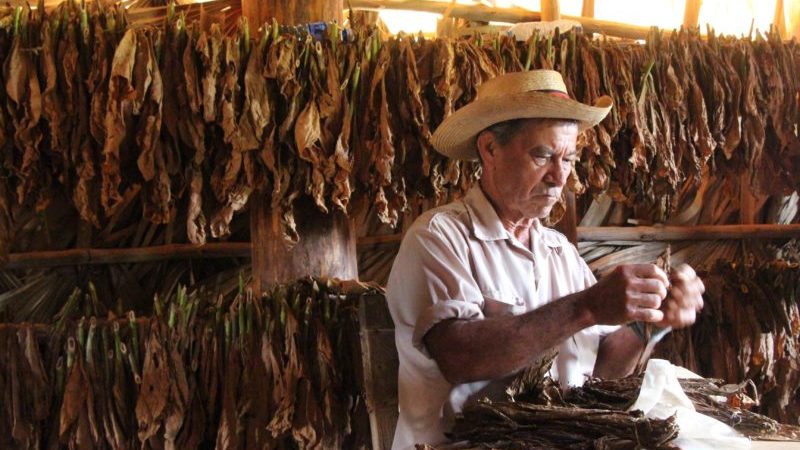 He lifted up the cigar a few times to make sure it all looked good, then continued to delicately roll the leaves until they formed a perfectly cylindrical shape. Deftly pulling out a small “chaveta” knife from his chest pocket, Roberto trimmed and cut the ends of the leaves to finish up the process.
He lifted up the cigar a few times to make sure it all looked good, then continued to delicately roll the leaves until they formed a perfectly cylindrical shape. Deftly pulling out a small “chaveta” knife from his chest pocket, Roberto trimmed and cut the ends of the leaves to finish up the process.
MORE FROM THIS WRITER: THE LIFE LESSONS THAT TRAVELING TO CUBA TAUGHT ME
He passed around his masterpiece for our group to admire, and as we “ooh’ed” and “aah’ed” at it, you could see the joy and pride in his eyes. Many of the members in our group had never smoked a cigar before, so when Roberto lit the cigar, we were excited to taste his hard work.
Everyone was surprised how delicious the fresh Cuban tobacco tasted, myself included!
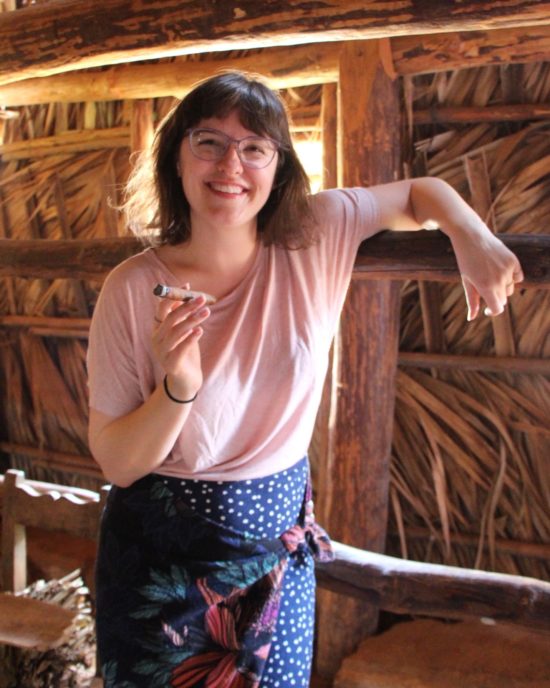
Trying my first Cuban cigar!
Final reflections
Roberto comes from a long line of tobacco farmers, and has worked in this industry his entire life. He took over his family finca in his early 30s, and has been sharing his natural talent and charisma with travelers for the last 20 years.
With the help of a translator, he generously answered our questions, teaching us about the long history and complicated process of tobacco growing in Western Cuba.
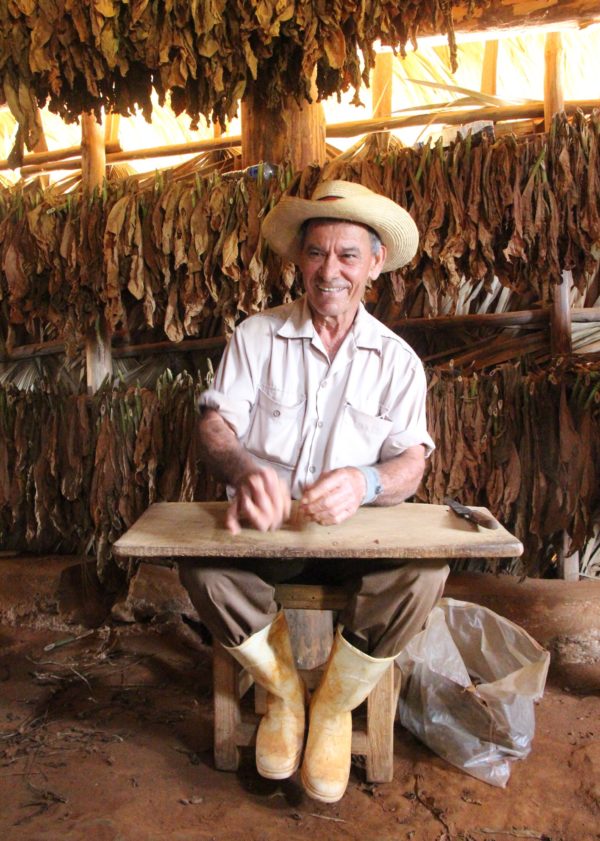
Roberto
The personal connection I developed with Roberto reminded me that the US-Cuba trade embargo doesn’t just damage relations between our nations, but takes away from the handmade art and culture that is imbued into each Cuban cigar.
When the first few puffs of the cigar hit my lips, I felt like I could taste the love, time and admiration that Roberto had rolled into that specific cigar. And for that, I was grateful.
Fancy experiencing a slice of authentic Cuban life? Check out Intrepid’s range of small group adventures in Cuba. US citizen? This 9-day ‘Hola Cuba’ trip is designed just for you!
(All images c/o Megan Arzbaecher at traverseblog.com)

